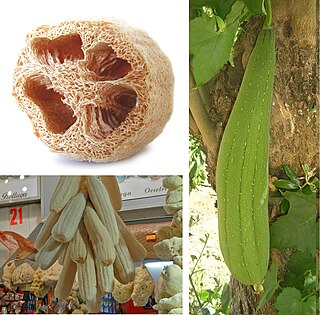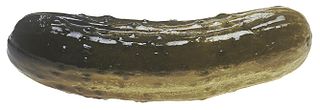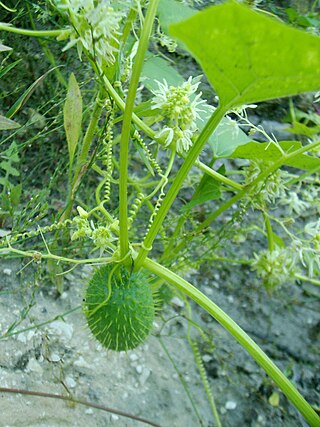
The shallot is a cultivar group of the onion. Until 2010, the shallot was classified as a separate species, Allium ascalonicum. The taxon was synonymized with Allium cepa in 2010, as the difference was too small to justify a separate species.

Gourds include the fruits of some flowering plant species in the family Cucurbitaceae, particularly Cucurbita and Lagenaria. The term refers to a number of species and subspecies, many with hard shells, and some without. One of the earliest domesticated types of plants, subspecies of the bottle gourd, Lagenaria siceraria, have been discovered in archaeological sites dating from as early as 13,000 BCE. Gourds have had numerous uses throughout history, including as tools, musical instruments, objects of art, film, and food.

Cucurbita is a genus of herbaceous fruits in the gourd family, Cucurbitaceae, native to the Andes and Mesoamerica. Five edible species are grown and consumed for their flesh and seeds. They are variously known as squash, pumpkin, or gourd, depending on species, variety, and local parlance. Other kinds of gourd, also called bottle-gourds, are native to Africa and belong to the genus Lagenaria, which is in the same family and subfamily as Cucurbita, but in a different tribe. These other gourds are used as utensils or vessels, and their young fruits are eaten much like those of the Cucurbita species.

The cucumber is a widely-cultivated creeping vine plant in the family Cucurbitaceae that bears cylindrical to spherical fruits, which are used as culinary vegetables. Considered an annual plant, there are three main types of cucumber—slicing, pickling, and seedless—within which several cultivars have been created. The cucumber originates in Asia extending from India, Nepal, Bangladesh, China, and Northern Thailand, but now grows on most continents, and many different types of cucumber are grown commercially and traded on the global market. In North America, the term wild cucumber refers to plants in the genera Echinocystis and Marah, though the two are not closely related.

A chutney is a spread typically associated with cuisines of the Indian subcontinent. Chutneys are made in a wide variety of forms, such as a tomato relish, a ground peanut garnish, yogurt or curd, cucumber, spicy coconut, spicy onion or mint dipping sauce.

Chayote, also known as mirliton and choko, is an edible plant belonging to the gourd family, Cucurbitaceae. This fruit was first cultivated in Mesoamerica between southern Mexico and Honduras, with the most genetic diversity available in both Mexico and Guatemala. It is one of several foods introduced to the Old World during the Columbian Exchange. At that time, the plant spread to other parts of the Americas, ultimately causing it to be integrated into the cuisine of many Latin American nations.

The Armenian cucumber, Cucumis melo var. flexuosus, is a type of long, slender fruit which tastes like a cucumber and looks somewhat like a cucumber inside. It is actually a variety of true melon, a species closely related to the cucumber. It is also known as the yard-long cucumber, snake cucumber, snake melon, chanbar in Persian, tirozî in Kurdish, sheng in Semnani, uri in Japanese, acur in Turkish, kakadee in Hindi, tar in Punjabi, قثاء in Arabic, commarella or tortarello in Italian. It should not be confused with the snake gourds. The skin is very thin, light green, and bumpless. It has no bitterness and the fruit is almost always used without peeling. It is also sometimes called a gutah.

Pickling is the process of preserving or extending the shelf life of food by either anaerobic fermentation in brine or immersion in vinegar. The pickling procedure typically affects the food's texture and flavor. The resulting food is called a pickle, or, if named, the name is prefaced with the word, 'pickled'. Foods that are pickled include vegetables, fruits, mushrooms, meats, fish, dairy and eggs.
Salmagundi is a cold dish or salad made from different ingredients which may include meat, seafood, eggs, cooked and raw vegetables, fruits, or pickles. In English culture, the term does not refer to a single recipe but describes the grand presentation of a large plated salad of many disparate ingredients. These can be arranged in layers or geometrical designs on a plate or mixed. The ingredients are then drizzled with a dressing. The dish includes a wide range of flavours and colours and textures on a single plate. Often recipes allow the cook to add various ingredients which may be available at hand, producing many variations of the dish. Flowers from broom and sweet violet were often used.
Balsam apple may refer to:

Melothria scabra, commonly known as the cucamelon, Mexican miniature watermelon, Mexican sour cucumber, Mexican sour gherkin, mouse melon, or pepquinos, is a species of flowering plant in the cucurbit family grown for its edible fruit. Its native range spans Mexico to Venezuela. Cucumis melo Agrestis and Cucumis callosus is cultivated as Chibber Fruit or Kachri in South Asia and can also grow as weed. Fruits are about the size of grapes and taste like cucumbers with a tinge of sourness. It may have been eaten by indigenous peoples before the European colonization of the Americas began.

Luffa aegyptiaca, the sponge gourd, Egyptian cucumber or Vietnamese luffa, is an annual species of vine cultivated for its fruit, native to South and Southeast Asia.

Luffa acutangula is a cucurbitaceous vine that is commercially grown for its unripe fruits as a vegetable. Mature fruits are used as natural cleaning sponges. Its fruit slightly resembles a cucumber or zucchini with ridges. It ranges from central and eastern Asia to southeastern Asia. It is also grown as a houseplant in places with colder climates. English common names include angled luffa, Chinese okra, dish cloth gourd, ridged gourd, sponge gourd, vegetable gourd, strainer vine, ribbed loofah, silky gourd, silk gourd,
A pickle is a food that has undergone pickling.

A pickled cucumber – commonly known as a pickle in the United States and Canada and traditionally a gherkin in Britain, Ireland, South Africa, Australia, and New Zealand – is a usually small or miniature cucumber that has been pickled in a brine, vinegar, or other solution and left to ferment. The fermentation process is executed either by immersing the cucumbers in an acidic solution or through souring by lacto-fermentation. Pickled cucumbers are often part of mixed pickles.

Echinocystis is a monotypic genus in the gourd family, Cucurbitaceae. The sole species is E. lobata, commonly called wild cucumber, prickly cucumber or bur cucumber. It is an annual, sprawling plant that is native to North America.
Gherkin is a common name for a pickled cucumber, especially in British English.












